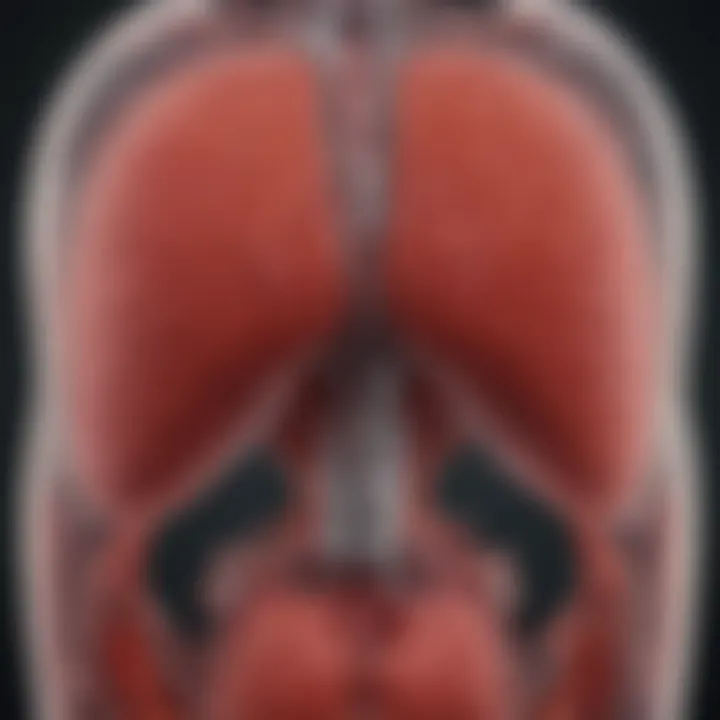Understanding Acute Alcohol Intoxication: A Detailed Overview


Intro
Acute alcohol intoxication, or alcohol poisoning, represents a significant public health issue that arises from the excessive intake of alcoholic beverages. This phenomenon is not merely a matter of overindulgence but involves a complex interplay between physiological responses and psychological effects. Understanding this condition is critical, as it has far-reaching consequences not only for the individual but also for society as a whole.
In this article, we will dissect various facets of acute alcohol intoxication, from its underlying causes to its implications on health. We will delve into how alcohol is absorbed in the body and the risk factors that can exacerbate the likelihood of becoming intoxicated. Furthermore, we will explore treatment options and preventive strategies that can mitigate this risk.
By using scientific studies and recent data, we aim to present a thorough examination worthy of attention from students, researchers, and health professionals alike. The information provided here is intended to foster a deeper understanding of alcohol's impact on health and to emphasize the importance of responsible consumption.
Prelims to Acute Alcohol Intoxication
Acute alcohol intoxication is a significant topic, given its relevance to public health and safety. Consequences of heavy drinking can be dire, impacting not just the individual but also the larger community. Understanding it is crucial because many people encounter situations where excessive alcohol consumption leads to a range of health problems.
Definition and Overview
Acute alcohol intoxication, frequently referred to as alcohol poisoning, occurs when a person consumes alcohol at an excessive rate, leading to dangerous physical and mental effects. This condition is characterized by a range of symptoms, which can include confusion, vomiting, seizures, slow breathing, and even unconsciousness. The level of intoxication is determined by the blood alcohol concentration (BAC), which varies according to numerous factors such as body weight, gender, and the rate of alcohol intake. When BAC rises significantly, it surpasses the body’s ability to metabolize alcohol, causing the intoxicated individual to become increasingly impaired. Furthermore, acute intoxication can lead to long-lasting health issues, emphasizing the importance of recognizing and addressing it promptly.
Historical Context
The history of alcohol consumption stretches back thousands of years. Ancient civilizations employed fermented beverages for social, medicinal, and ceremonial purposes. However, the adverse effects of alcohol were not always comprehended. In various societies, alcohol was celebrated, often without full acknowledgment of its risks. It was not until the 20th century that medical professionals began to identify symptoms and consequences of acute intoxication more systematically. The rise of alcohol-related complications led to the creation of laws and public health campaigns aimed at reducing excessive drinking. These historical insights into the relationship between alcohol and society show that while alcohol has been a part of human culture, its potential for harm calls for a deeper understanding, especially in an era where binge drinking is prevalent.
"Recognizing the history of alcohol consumption offers insight into current patterns of use and misuse."
This comprehensive view not only informs medical approaches but also proves essential for educating the public about responsible drinking practices. By understanding the evolution of alcohol's role in society, we can better address the challenges posed by acute alcohol intoxication today.
Epidemiology of Acute Alcohol Intoxication
Epidemiology plays a crucial role in understanding acute alcohol intoxication. It involves studying the distribution and determinants of this health issue across different populations. Knowing how widespread acute alcohol intoxication is helps researchers and health professionals to identify at-risk groups. This knowledge ultimately can guide prevention and intervention strategies that can significantly reduce the occurrence of acute intoxication. Also, by understanding environmental, behavioral, and demographic factors, stakeholders can create informed policies to tackle the problem effectively.
Prevalence Rates
The prevalence rates of acute alcohol intoxication can vary significantly based on several factors. Generally, these rates indicate how frequently instances of intoxication occur within a defined population over a specific time. Statistics often show that alcohol-related incidents are prevalent across various regions and demographic groups.
According to data from various studies, acute alcohol intoxication tends to peak during weekends and public holidays. Social gatherings often lead to increased alcohol consumption, resulting in higher rates of intoxication. For instance, statistics from the National Institute on Alcohol Abuse and Alcoholism indicate that in the United States, binge drinking—sometimes leading to acute alcohol intoxication—is reported by about 1 in 6 adults. This behavior is marked by consuming four or more drinks for women and five or more for men in about two hours.
Demographic Factors
Demographic factors significantly influence the rates of acute alcohol intoxication. Various elements such as age, gender, socio-economic status, and education level can dictate one’s drinking behavior. Here’s a breakdown of key demographic influences:
- Age: Young adults, particularly those aged 18 to 24, show higher prevalence rates of acute alcohol intoxication. This age group often experiences social pressures that promote higher rates of drinking.
- Gender: Males generally experience acute alcohol intoxication more frequently than females. Social norms often encourage higher alcohol consumption in men.
- Socio-Economic Status: Research indicates that individuals from lower socio-economic backgrounds may engage in risky drinking patterns due to various factors, including stress and limited access to education about alcohol harms.
- Education: Lower levels of education are linked to higher rates of acute intoxication. Often, those with less formal education are not as informed about the consequences of excessive drinking.
Understanding these demographic factors is invaluable for health professionals and policymakers. It allows them to target specific groups for educational campaigns and develop more effective intervention strategies to mitigate the risks associated with acute alcohol intoxication.
"Epidemiology isn’t just about numbers; it allows us to hear the voices of those affected by alcohol misuse and arm ourselves with knowledge to combat the crisis."
In summary, the study of the epidemiology of acute alcohol intoxication reveals significant insights into who is affected, the prevalence of these occurrences, and how we can potentially address this public health issue effectively.
Physiological Mechanisms of Alcohol Intoxication
The study of physiological mechanisms related to alcohol intoxication provides significant insights into how the body reacts to alcohol. Understanding these mechanisms is crucial for medical professionals and researchers alike. It helps in recognizing the immediate effects of alcohol, guiding treatment approaches and preventive measures. In this section, two critical components of this topic will be covered: absorption and metabolism, and blood alcohol concentration.
Absorption and Metabolism
When alcohol enters the body, it is primarily absorbed through the stomach and the small intestine. The factors influencing this absorption include the type of beverage consumed, the presence of food in the stomach, and individual physiology. For example, higher alcohol concentrations in drinks like spirits tend to lead to quicker absorption rates compared to beer or wine.
Once absorbed, alcohol travels through the bloodstream to the liver, where it is metabolized. The liver plays a vital role in breaking down alcohol. An enzyme known as alcohol dehydrogenase converts alcohol to acetaldehyde, which is then further metabolized to acetate by aldehyde dehydrogenase. This process is crucial as it determines the rate at which the body can eliminate alcohol.
Factors such as genetics, age, and overall health can affect the efficiency of these enzymes, leading to variations in how different individuals metabolize alcohol. This variability is important as it can influence the risk of developing alcohol-related problems.
Blood Alcohol Concentration
Blood alcohol concentration (BAC) is a measure that expresses the amount of alcohol in a person's bloodstream. It is an essential aspect of understanding acute alcohol intoxication. BAC is typically expressed as a percentage and is affected by several factors including the amount of alcohol consumed, time elapsed since consumption, and individual metabolic rates.
A higher BAC level correlates with more pronounced effects of intoxication. The legal limit for driving in many regions is 0.08%. At this level, impairment begins to be noticeable, affecting motor skills and cognitive functions. It is crucial to understand that even lower levels of BAC can result in impairment, especially in sensitive individuals.
"A BAC of 0.05% can lead to decreased coordination and judgment, making activities like driving dangerous."
Monitoring BAC can provide valuable insights into a person's level of intoxication, which is crucial for assessing health risks and determining appropriate interventions. Understanding how alcohol is absorbed and metabolized, along with the effects of BAC, lays the groundwork for a deeper comprehension of the short-term and long-term consequences of acute alcohol intoxication.
Causes of Acute Alcohol Intoxication
The causes of acute alcohol intoxication are essential facets of understanding how alcohol affects individuals adversely. Recognizing what leads to such severe intoxication can help identify at-risk populations and develop preventive strategies. It is critical to analyze the behavior patterns and situational factors that contribute to this public health issue.
Excessive Consumption Patterns
One of the primary causes of acute alcohol intoxication is excessive consumption patterns. This occurs when individuals drink alcohol in amounts that exceed their body’s capacity to metabolize it. Binge drinking is a common behavior associated with such patterns. According to the National Institute on Alcohol Abuse and Alcoholism, binge drinking is defined as consuming five or more drinks within two hours for men, and four or more for women.
The social context is often connected with these consumption patterns. Events such as parties, celebrations, or communal gatherings can lead to a perception that it is acceptable to drink larger quantities. Peer pressure can influence individuals, making them feel compelled to keep up with others. Understanding these excessive consumption patterns is crucial as they directly correlate with the risk of acute intoxication.
Additionally, lower tolerance levels in certain individuals can exacerbate the effects of drinking. Those who drink less frequently or are inexperienced drinkers are more likely to experience acute intoxication even after consuming smaller amounts of alcohol.
"Knowledge of drinking patterns can lead to better health interventions and educational efforts aimed at reducing binge drinking risk factors."
Situational Influences


Situational influences play a significant role in the occurrence of acute alcohol intoxication. Various environmental and psychological factors can affect an individual's drinking behavior. Settings such as bars, nightclubs, or festivals often promote higher consumption levels due to their social and cultural norms.
Stressful situations can also trigger excessive drinking as an avoidance or coping mechanism. Individuals may consume alcohol to deal with anxiety, depression, or social pressures without fully understanding the risks associated with their drinking behaviors.
The availability of alcohol can also substantially influence consumption rates. If alcohol is readily accessible, individuals might drink more than they originally intended. Context is crucial; environments that condone or encourage heavy drinking can lead to severe intoxication.
Understanding these situational influences enables researchers and health professionals to design targeted interventions. It can help in crafting environmental policies aimed at controlling alcohol availability and promoting healthier drinking norms in social settings.
Symptoms of Acute Alcohol Intoxication
Understanding the symptoms of acute alcohol intoxication is vital. These symptoms can range from mild to severe and indicate the level of impairment. Recognizing these signs allows for timely intervention. This section will highlight the critical physical and cognitive symptoms, offering insights into their implications.
Physical Symptoms
Physical symptoms of acute alcohol intoxication manifest clearly. Common indicators include slurred speech, unsteady gait, and decreased coordination. Other signs encompass nausea, vomiting, and, in severe cases, loss of consciousness. These symptoms signify the body struggling to process alcohol.
- Slurred Speech: This is often the first noticeable sign. The person may have difficulty articulating words clearly.
- Impaired Coordination: Tasks requiring complex movements become challenging, leading to potential accidents.
- Altered Breathing Patterns: Breathing may become irregular, which can signify a critical state of intoxication.
- Vomiting: Displayed by the stomach’s effort to expel excess alcohol.
- Hypothermia: A potentially severe condition, especially in cold environments, may result from prolonged intoxication.
Recognizing these physical symptoms is crucial for preventing complications. They can escalate quickly, leading to life-threatening situations such as respiratory failure or coma. Immediate assistance is often required to ensure safety.
Cognitive and Behavioral Symptoms
Cognitive and behavioral symptoms often emerge alongside physical signs. These include confusion, decreased judgment, and altered emotional responses. Such symptoms provide insights into how alcohol influences neurological functions.
- Confusion: This can present as disorientation regarding time and place, indicating significant impairment.
- Judgment Issues: Alcohol lowers inhibitions and distorts rational thinking. This can lead individuals to make poor decisions, resulting in unsafe situations.
- Memory Impairment: Short-term memory may be compromised, which can affect subsequent reactions to events.
- Mood Swings: Intoxicated individuals may display extreme emotional fluctuations ranging from aggression to euphoria.
- Risky Behaviors: Increased engagement in unsafe activities increases, including reckless driving or unprotected sex.
Understanding these cognitive and behavioral symptoms helps in gauging the seriousness of alcohol intoxication. Monitoring these signs can aid in assessing the need for medical intervention and guiding friends and family in providing necessary support.
Understanding both physical and cognitive symptoms presents a complete view of acute alcohol intoxication, highlighting the need for awareness and immediate response.
Short-Term Consequences of Acute Intoxication
Acute alcohol intoxication can lead to a variety of short-term consequences that affect both health and social interactions. Understanding these consequences is crucial in order to grasp the magnitude of alcohol's impact on individuals and society as a whole. By highlighting potential health risks and social implications, we can better appreciate the urgency of awareness and intervention strategies.
Health Risks
The immediate health risks associated with acute alcohol intoxication are significant and can vary widely among individuals. Some of the major health concerns include:
- Respiratory Depression: High levels of alcohol can depress the central nervous system, leading to impaired breathing. In extreme cases, this may result in respiratory failure and require emergency medical attention.
- Hypothermia: Alcohol can cause a drop in body temperature by dilating blood vessels, increasing heat loss. Those who consume large amounts in cold environments may be at risk for hypothermia.
- Cardiovascular Problems: Acute consumption may trigger irregular heartbeats and elevated blood pressure. Such cardiovascular risks highlight the strain acute intoxication can place on the heart.
- Severe Vomiting: Excessive drinking can lead to retching and vomiting, which can pose the risk of choking, aspiration pneumonia, and dehydration.
- Acute Pancreatitis: In heavy drinkers, acute alcohol intoxication can lead to inflammation of the pancreas, resulting in severe abdominal pain and other complications that require immediate treatment.
These risks underscore the necessity for timely intervention and the importance of monitoring individuals under the influence for signs of distress.
Social Implications
In addition to health risks, the social implications of acute alcohol intoxication cannot be overlooked. Heavy drinking in social contexts can lead to:
- Increased Aggression: Alcohol often lowers inhibitions, potentially leading to aggressive behavior. This can escalate into fights or violence not only among individuals but also within communities.
- Disruption of Relationships: Acute intoxication can strain personal and professional relationships. Impaired judgment can lead to conflicts, misunderstandings, or reckless behavior that alienates friends and family.
- Risk of Accidents: Alcohol impairs motor skills and decision-making, increasing the likelihood of accidents, including falls, injuries, and motor vehicle incidents. This affects not just the drinker but also bystanders.
- Legal Consequences: Many jurisdictions hold individuals accountable for their actions while under the influence of alcohol. This can result in criminal charges, fines, or civil liability for damages caused.
- Stigmatization: Individuals who frequently experience acute intoxication may face stigma in social settings, impacting their reputation and mental well-being.
The short-term consequences of acute alcohol intoxication can reverberate beyond the individual, impacting families, friends, and wider communities.
Given these health risks and social issues, addressing acute alcohol intoxication is not only a matter of health—it is a multi-dimensional challenge that intersects with social, legal, and community dynamics.
Long-Term Outcomes of Habitual Intoxication
The long-term outcomes of habitual intoxication are critical to understanding the broader consequences of alcohol misuse. When individuals regularly consume excessive alcohol, their bodies and minds endure various changes. Identifying these outcomes helps to emphasize the need for prevention and treatment strategies. It also aids in understanding how habitual drinking can alter a person's trajectory in life. These changes can range from chronic health issues to significant psychological effects, both of which warrant careful consideration by individuals, healthcare professionals, and policymakers.
Chronic Health Conditions
Habitual alcohol intoxication can lead to a range of chronic health conditions that severely impact an individual’s well-being. Some of the most prevalent conditions include:
- Liver Disease: Long-term alcohol use is a well-known risk factor for liver diseases, including fatty liver, alcoholic hepatitis, and cirrhosis. These conditions can lead to liver failure, necessitating transplantation or resulting in death.
- Cardiovascular Problems: Chronic alcohol consumption escalates the risk of hypertension, cardiomyopathy, and arrhythmias. Damage to heart tissue can be irreversible, leading to long-term complications.
- Pancreatitis: Habitual heavy drinking is a significant cause of both acute and chronic pancreatitis, characterized by inflammation of the pancreas, which can affect digestion and blood sugar regulation.
- Cancer: Studies have linked alcohol consumption with various cancers, including breast, liver, and esophageal cancers. The mechanisms behind this relationship are complex, involving both direct toxic responses and impairment of the immune system.
- Neurological Disorders: Chronic alcohol abuse increases the risk of neurocognitive disorders, including Wernicke-Korsakoff syndrome, which results from thiamine deficiency.
The onset of these conditions underscores the critical nature of addressing long-term alcohol misuse as early as possible. Regular screenings and interventions can help mitigate these risks.
Psychological Effects
Beyond physical health, habitual alcohol intoxication imposes significant psychological effects that can be long-lasting. These issues include:
- Cognitive Impairments: Long-term alcohol use can result in deficits in memory, attention, and problem-solving abilities. Studies indicate that even moderate chronic consumption can lead to changes in brain structure, affecting cognitive function.
- Mood Disorders: Individuals with a history of heavy drinking often experience mood disorders, such as depression and anxiety. Alcohol can serve as a depressant, and its withdrawal can exacerbate underlying mental health issues.
- Addiction and Dependence: Chronic exposure to alcohol can lead to psychological dependence. The resultant cravings can create a cycle of consumption that is difficult to break, perpetuating the cycle of abuse and dependence.
- Social Withdrawal: Psychological effects of habitual drinking may lead to isolation. This withdrawal can affect relationships with family, friends, and colleagues, compounding feelings of loneliness and hopelessness.
The psychological ramifications of long-term alcohol misuse can be profoundly isolating, leading individuals to a path of increasing detachment from the outside world.
Risk Factors for Acute Alcohol Intoxication
Understanding the risk factors for acute alcohol intoxication is crucial in addressing the broader implications of alcohol consumption on individual health. Identifying these factors can lead to better prevention strategies, targeted interventions, and a more informed approach to alcohol-related issues. Risk factors can be broadly categorized into demographic vulnerabilities and behavioral and environmental influences, each of which plays a significant role in increasing the likelihood of acute intoxication.
Demographic Vulnerabilities
Demographic factors are integral in shaping how individuals respond to alcohol. Age, gender, socioeconomic status, and cultural background all contribute to susceptibility to acute intoxication. Studies show that younger individuals, particularly those in their late teens to mid-twenties, are more likely to engage in binge drinking behaviors, elevating their risk of acute intoxication.
Gender differences also play a role. Men, statistically, have higher rates of alcohol consumption compared to women. This disparity results in higher rates of acute alcohol intoxication among male populations. Additionally, women may be at greater risk due to factors like body composition and metabolic rates. Their lower average body water content results in higher blood alcohol concentrations when consuming equivalent amounts of alcohol as men.
Socioeconomic factors also influence alcohol consumption patterns. Individuals from lower socioeconomic backgrounds may experience higher levels of stress, leading to increased alcohol use as a coping mechanism. Moreover, they may have limited access to healthcare resources, reducing their ability to receive help in case of intoxication.
"Understanding how demographic factors correlate with alcohol use can illuminate the pathways to more effective prevention methods."


Behavioral and Environmental Factors
Behavioral patterns significantly contribute to the risk of acute alcohol intoxication. These patterns are often influenced by social environments and peer pressures. College campuses, for example, tend to foster environments that normalize excessive drinking. This often results in binge drinking, particularly during social events, creating an environment ripe for acute alcohol intoxication.
Moreover, cultural attitudes toward drinking can impact consumption behavior. In some cultures, drinking is integrated into social gatherings, encouraging excess consumption. In contrast, communities that emphasize moderation may experience lower rates of intoxication.
Another key element is the availability of alcohol. Regions with prevalent access to alcohol, whether through supermarkets, bars, or events, often show increased rates of intoxication. Moreover, festivities tend to normalize heavy drinking, further exacerbating the risks.
Assessment and Diagnosis
The topic of assessment and diagnosis is crucial for effective management of acute alcohol intoxication. Recognizing the signs of alcohol poisoning promptly can save lives and mitigate severe health implications. Often, the symptoms of intoxication can overlap with other medical conditions, making it necessary for healthcare providers to conduct thorough evaluations. This section outlines the key aspects of clinical evaluation and laboratory tests that aid in diagnosing acute alcohol intoxication.
Clinical Evaluation
Clinical evaluation serves as the first step in the assessment process. It involves the initial observation of symptoms and a detailed history of the patient's drinking behavior. Medical professionals typically follow a systematic approach that includes several key elements:
- History Taking: Gathering information about the amount and duration of alcohol consumption. This is vital for establishing the severity of intoxication.
- Physical Examination: Assessing the patient for physical signs such as slurred speech, unsteady gait, and altered mental status. These symptoms provide initial insights into the level of impairment.
- Vital Signs Monitoring: Checking blood pressure, heart rate, and respiratory rate is essential. Abnormal vital signs can provide clues about the patient's condition and potential complications.
Effective clinical evaluation often involves the use of established scales, such as the Glasgow Coma Scale, which helps gauge the level of consciousness. Overall, clinical evaluation establishes a baseline for further investigation and necessary immediate interventions.
Laboratory Tests
While clinical evaluation is essential, laboratory tests complement the diagnosis of acute alcohol intoxication. These tests help quantify blood alcohol concentration (BAC) and identify any accompanying metabolic or physiological abnormalities. Typical laboratory assessments include:
- Blood Alcohol Concentration (BAC) Measurement: A direct and quantitative measure of alcohol in the bloodstream. Typically, a BAC of 0.08% is considered legally impaired in many jurisdictions, but risks increase significantly above this level.
- Basic Metabolic Panel (BMP): Evaluates electrolyte levels and kidney function. Metabolic disturbances may arise due to excessive alcohol consumption.
- Liver Function Tests (LFTs): Assessing liver enzymes can indicate possible alcohol-related liver injury. Test results can reflect the severity of liver damage.
"Accurate assessment and timely diagnosis are critical in the management of acute alcohol intoxication, potentially preventing serious morbidity or mortality."
Through comprehensive laboratory testing, clinicians can better understand the full impact of alcohol on a patient's health. This information is vital for choosing an appropriate treatment strategy and ensuring a positive outcome for those affected by acute alcohol intoxication.
Treatment Approaches
Treatment for acute alcohol intoxication encompasses a range of strategies aimed at addressing both immediate and long-term needs of those affected. Understanding the importance of these practices is crucial for effectively mitigating health risks and promoting a path to recovery. The complexity of alcohol intoxication varies significantly by individual circumstances, body chemistry, and the amount of alcohol consumed. Therefore, responsive treatment approaches tailored to the patient’s condition are vital.
Immediate Care Practices
Immediate care is often the first line of defense in managing acute alcohol intoxication. It typically occurs in emergency settings where swift action can prevent severe outcomes such as coma or death. Key components of immediate care include:
- Assessment: Medical professionals begin with a thorough evaluation of the patient's vital signs and level of consciousness. This step is essential to determine the severity of the intoxication.
- Supportive Care: Patients may require assistance with breathing, intravenous fluid administration, and monitoring for complications. Providing oxygen or intubation, in extreme cases, can stabilize the individual’s respiratory function.
- Gastric Decontamination: In some situations, activated charcoal may be administered if ingestion is recent, to limit further absorption of alcohol.
- Monitoring for Complications: Continuous observation for any signs of respiratory depression, cardiovascular instability, or neurological issues is important in the first few hours post-admission.
This phase of treatment aims to provide stability and minimize the risk of severe complications that could arise from high levels of blood alcohol concentration.
Long-Term Intervention Strategies
Once immediate care has stabilized the individual, long-term intervention strategies become crucial. These strategies promote recovery and aim to prevent future incidents of acute alcohol intoxication. Important aspects include:
- Behavioral Therapy: Engaging patients in counseling can help address underlying issues related to their alcohol use. Cognitive-behavioral therapy (CBT) is commonly effective in altering drinking patterns.
- Support Groups: Participation in organizations such as Alcoholics Anonymous can offer ongoing support and accountability from peers who understand the challenges of recovery.
- Medical Management: For some individuals, medications such as naltrexone or acamprosate may be prescribed to reduce cravings and assist in maintaining sobriety.
- Education and Skill Development: Providing education on the risks of alcohol and developing coping strategies to handle stress or social pressure is essential.
Long-term intervention strategies are not only about sobriety but also about improving overall health and quality of life. Ensuring a supportive environment, along with professional guidance, allows for recovery to be sustainable.
"Effective treatment not only addresses the current state of intoxication but also prepares individuals for healthier lifestyles in the future."
In summary, effective treatment approaches combine immediate care with long-term strategies to combat acute alcohol intoxication. These measures are designed to ensure both the safety and recovery of individuals, ultimately fostering a comprehensive understanding of their relationship with alcohol.
Preventive Measures
Preventive measures play a crucial role in addressing the issue of acute alcohol intoxication. By focusing on both education and regulatory frameworks, we can create a safer drinking environment and mitigate the risks associated with excessive alcohol consumption. Understanding these preventive strategies is essential for students, researchers, and professionals alike, as they contribute to a healthier society.
Education and Awareness Campaigns
Education is the cornerstone of any effective preventive measure against acute alcohol intoxication. Awareness campaigns aim to inform individuals about the dangers associated with excessive drinking. These initiatives can be implemented in various settings, including schools, universities, and communities.
The effectiveness of these campaigns is enhanced when they are tailored to specific demographics. For example, younger individuals may benefit from peer-led programs that resonate with their experiences. Campaigns can use social media platforms like Facebook or even Reddit to reach a wider audience, making the information accessible.
Key elements of these campaigns include:
- Clear messaging about the risks of overconsumption.
- Personal stories that humanize the statistics on alcohol-related harm.
- Interactive activities that engage individuals in discussions about safe drinking habits.
Implementing these campaigns effectively requires collaboration among various stakeholders. Schools, healthcare providers, and local organizations can work together to maximize their reach.
"Education is essential to combatting alcohol intoxication; knowledge is the first step toward safer choices."
Policy and Regulation Considerations
Policy and regulation are essential for creating a robust framework to prevent acute alcohol intoxication. Governments play a significant role in establishing laws that can deter excessive drinking behaviors. These regulations must consider both the availability of alcohol and the environment in which it is consumed.
Important aspects of effective policies include:
- Restricting sales to underage consumers, ensuring that strict age verification is in place.
- Limiting hours of alcohol sales in certain establishments, especially during late-night hours when intoxication risks increase.
- Implementing penalties for establishments that serve alcohol to visibly intoxicated individuals.
In addition, policies should encourage responsible drinking by promoting low-risk drinking guidelines. This includes providing clear information on serving sizes and what constitutes moderate drinking.
Successful regulations are often enforced through collaborations between local law enforcement, public health officials, and community advocates. By fostering this multi-faceted approach, society can better protect its members from the hazards of acute alcohol intoxication.


Cultural Perspectives on Alcohol Consumption
Cultural perspectives on alcohol consumption play a crucial role in understanding acute alcohol intoxication. This aspect encompasses the various beliefs, behaviors, and practices associated with drinking alcohol across different societies. By analyzing these cultural contexts, one can gain insight into how cultural norms shape individuals' drinking habits and attitudes toward intoxication. Not only does this inform public health strategies, but it also aids in developing educational campaigns tailored to specific communities.
Cultural Norms and Alcohol Use
Cultural norms surrounding alcohol vary widely across different regions and societies. In some cultures, drinking is a profound social event, promoted by gatherings, celebrations, and rituals. In contrast, other cultures may view alcohol consumption as undesirable or inappropriate. For example, in Mediterranean countries like Spain or Italy, moderate drinking during meals is common and socially accepted. Here, wine is often seen as part of the dining experience rather than as a means to achieve intoxication.
Conversely, many Asian cultures impose strict regulations on alcohol consumption due to the potential for negative perceptions and health concerns, particularly surrounding acute intoxication. The stigma and severity of these health concerns can influence the amount and context in which alcohol is consumed. This highlights the importance of understanding these cultural variations when discussing the health implications of alcohol, including acute intoxication.
Influence of Tradition on Drinking Habits
Tradition is another underpinning factor that influences drinking habits and tolerances. Certain cultural practices reflect historical attitudes towards alcohol, shaping modern consumption patterns. For instance, in indigenous cultures, alcohol may be used ceremonially, designated for specific events or spiritual rituals. As these traditions evolve, so can the approaches to and understanding of alcohol consumption.
Moreover, in cultures undergoing rapid modernization, traditional drinking habits may clash with new societal norms. This can create a dichotomy in drinking behavior, where individuals may struggle between adhering to traditional values and embracing modern consumption patterns.
Other historical factors like colonialism and globalization also play roles in altering drinking habits within cultures. For example, exposure to Western drinking cultures can lead to changes in local practices and norms regarding alcohol. Individuals might adopt drinking patterns from different cultures, sometimes resulting in excessive use and potential for acute intoxication.
Understanding these perspectives can lead to tailored prevention efforts that resonate better with diverse populations.
In sum, a comprehensive examination of cultural influences provides a solid foundation for addressing the complexities of acute alcohol intoxication, allowing for effective strategies to mitigate its impact.
Legal Implications
Understanding the legal implications surrounding acute alcohol intoxication is crucial for multiple reasons. This section addresses the legal frameworks that govern alcohol consumption and the potential liabilities that may arise in acute cases. Legal implications provide insight into how the system manages the consequences of intoxication, which can affect individuals and society at large.
Regulatory Frameworks
Regulatory frameworks are established to guide the responsible consumption of alcohol and to clarify the legal boundaries within which individuals and establishments operate. Various laws are in place to regulate the sale, distribution, and consumption of alcoholic beverages. These include minimum drinking age laws, taxation policies, and licensing requirements for vendors.
These laws serve several purposes:
- Preventing Underage Drinking: Legal age limits aim to deter access to alcohol for minors, thereby reducing the risk of acute intoxication in this vulnerable population.
- Establishing Safe Consumption Practices: Regulations often mandate responsible service of alcohol, including training staff to recognize signs of intoxication.
- Encouraging Public Safety: By setting legal standards for blood alcohol concentration (BAC) limits for drivers, regulations help to reduce drunk driving incidents, which can lead to accidents and fatalities.
An understanding of these regulatory frameworks is essential for individuals and institutions to navigate their responsibilities and rights concerning alcohol consumption. Failure to comply may result in legal consequences, ranging from fines to criminal charges.
Liability Issues in Acute Cases
Liability issues in acute alcohol intoxication cases can be complex. When intoxication leads to harm, determining responsibility is not always straightforward. Here are some key aspects to consider:
- Social Host Liability: In certain jurisdictions, individuals hosting parties where alcohol is served may be held liable if a guest becomes intoxicated and causes harm to themselves or others.
- Dram Shop Acts: Many regions have laws known as dram shop acts, which can hold bars and restaurants accountable for serving alcohol to visibly intoxicated patrons. This can extend to civil liability if those patrons subsequently cause injury.
- Legal Consequences for Individuals: Individuals who are found wholly responsible for their conduct while intoxicated may face penalties like DUI arrests or civil suits for damages caused while under the influence.
Understanding these liabilities is essential for mitigating risks associated with alcohol consumption and for promoting responsible drinking.
Future Directions in Research
The field of acute alcohol intoxication is evolving continuously. Research in this area is vital as it can lead to improved understanding and treatment of alcohol-related issues. The exploration of new trends and innovative policies can greatly enhance public health strategies. Firstly, emerging research is uncovering the complex relationship between genetics and alcohol use. Studies are increasingly showing how individual genetic profiles can influence alcohol metabolism. This information can guide personalized treatment plans.
Secondly, the role of mental health remains a significant consideration in the study of alcohol intoxication. Researchers are looking into how mental health disorders correlate with patterns of alcohol consumption. These insights could lead to better-targeted interventions for individuals facing both alcohol-related challenges and mental health issues.
"Understanding the multifaceted nature of alcohol consumption can greatly help in preventing and treating acute intoxication problems."
In addition, the field of behavioral economics is being applied to understand decision-making around alcohol consumption. This can provide valuable information on how to craft policies that reduce risky drinking behaviors. All of these factors contribute to the importance of systematic and critical research in the area of acute alcohol intoxication.
Emerging Trends in Alcohol Study
Emerging trends in alcohol study focus on both biological and environmental aspects. Researchers are currently exploring how societal trends impact alcohol usage patterns. For instance, the rise of social media influences drinking behavior among younger demographics. Subsequently, this awareness can transform how interventions are designed.
Furthermore, the impact of technology on data collection is significant. New methods utilizing wearable devices and smartphones provide real-time data on drinking habits and related health metrics. This advancement offers unprecedented research capabilities, allowing scientists to be more precise in their findings.
Lastly, the intersection of public health and law is gaining traction. Understanding regulations surrounding alcohol sales and consumption is crucial. This can lead to better understanding of how these laws can be optimally developed to protect community health.
Health Innovations and Alcohol Policy
Health innovations are reshaping the approach to alcohol policy dramatically. For instance, electronic health records now allow sufficient tracking of patients with alcohol dependency issues. This data can reveal trends and aid in resource allocation more effectively.
Moreover, new treatment modalities such as teletherapy for alcohol abuse are emerging. These methods adapt traditional therapy to reach wider audiences, particularly during crises like the COVID-19 pandemic. The outcomes show promising potential for this approach to become a standard part of alcohol treatment strategies.
In terms of policy, there is a push toward stricter regulations on advertising and availability of alcohol. Studies suggest that reducing alcohol accessibility correlates with lower rates of acute intoxication. This could be an essential direction in public policy. Implementing evidence-based policy decisions can enhance community health while considering cultural attitudes towards alcohol.
Collectively, these developments in research and policy aim to create a more informed framework for managing alcohol consumption and tackling acute intoxication effectively.
Epilogue
The conclusion section serves as a crucial capstone to the examination of acute alcohol intoxication. It synthesizes the information presented throughout the article, allowing readers to reflect on the various aspects of the topic. Understanding this condition is essential not just for academic purposes, but also for practical applications in public health and safety. It provides insight into how excessive alcohol consumption can disrupt both physiological functions and social interactions, underscoring the importance of awareness and prevention.
Summary of Key Findings
In our exploration, we highlighted several key factors regarding acute alcohol intoxication. The primary findings include:
- Definition Uniformity: Acute alcohol intoxication reflects significant physiological and psychological shifts resulting from excessive drinking.
- Prevalence and Demographics: It affects various demographics, with notable patterns emerging based on age and societal factors.
- Symptoms Spectrum: Physical and cognitive symptoms vary widely, impacting judgment, coordination, and overall health.
- Consequences: Both short-term and long-term effects present substantial health risks, including potential chronic conditions.
- Preventive Efforts: Effective prevention strategies can be implemented through public awareness and education campaigns.
This summary encapsulates the complexity of the issue while reiterating the necessity for continued research and public health discourse.
Final Thoughts and Recommendations
In final recommendations, individuals, educators, and public health officials should focus on fostering environments that reduce the risks associated with acute alcohol intoxication. Strategies include:
- Educational Initiatives: Implement programs to educate young adults on the dangers of excessive drinking.
- Policy Development: Advocate for policies that regulate alcohol availability and marketing, particularly to vulnerable groups.
- Support Systems: Create support networks for individuals in recovery or seeking to reduce their alcohol intake.
Ultimately, addressing acute alcohol intoxication requires a multifaceted approach that integrates research findings, community insight, and legislative action. The importance of understanding this health concern cannot be overstated, as it impacts not only individuals but also societal well-being.



